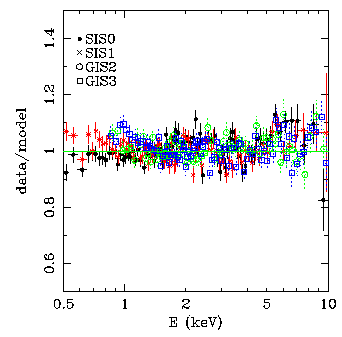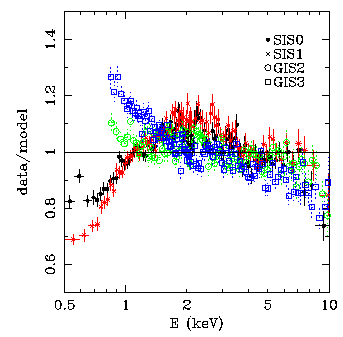Parameterization of SIS Efficiency Loss in 1-CCD Mode
(ASCA GOF Calibration Memo [ASCA-CAL-00-06-01, v1.0 (06/05/00): T. Yaqoob & ASCATEAM])
Since the launch of ASCA in 1993 the low-energy response of both SIS has been degrading both in effciency and energy resolution. Whilst some of this degradation is corrected by the tool CORRECTRDD a significant problem remains and results in an apparent divergence of the the SIS response compared to the GIS at low energies (see Fig. 1). The problem is likely to be related to the increase of dark current and decrease of charge transfer efficiency (CTE) and is the subject of on-going investiagtion by the ASCA team. Until this problem is fixed, we can try to quantify the apparent loss in SIS low-energy efficiency as a function of time throughout the mission, which will also help to understand and model the degradation. Indeed such a parameterization should help to get the correct form of the time-dependence of the eventual model. Note that the correct model, when it exists, will also correct for the change in energy resolution which is also not accounted for in the current software.
It is found that the efficiency loss can be parameterized crudely with excess absorption. Although this is very crude, at least it allows us to represent the degradation with a single number for each SIS at a snapshot in time. This has already been demsonstrated for a few 2-CCD mode observations in Hwang et al 1999 (ApJ 516, 604). The effect on 2-CCD and 4-CCD mode data is much worse than 1-CCD mode. In this report we consider principally the 1-CCD mode data. The magnitude of the problem is illustrated in Figure 1 below with two observations of 3C 273. In each case a 4-instrument simultaneous fit was performed with a power law plus Galactic absorption; however an additional power-law was included for the first observation (1993/day 160) to model a soft-excess and there may be extra intrinsic absorption in the second observation (2000/day 10-11) which is not included. The main point, however, is to illustrate the divergence of the four instruments at low energies, which does not depend on the model.
 |
 |
Summary and Bottom Line
We have crudely parameterized the low-energy degradation of the ASCA SIS-0 and SIS-1 versus time, with the primary purpose that the form of the relationship may provide important clues about the physical origin of the problem. The relationship is summarized in Figure 5.
The spectral characteristics of the low-energy problem appear to be complex but we simply characterized it by a simple number (an effective "excess absorption column density" for each SIS).
We derived a straight line fit to estimate this excess NH parameter for a given observation time for SIS-0 (a linear approximation is not good for SIS-1). The corresponding number for SIS-1 can be derived from the data itself by examining the model-independent SIS-1/SIS-0 ratio. If the signal-to-noise of the data is insufficient, then one need not worry abut correcting the data anyway since the statistics are then worse than the systematics.
Until a physical model of the CCD degradation is available one should only use this parameterization to estimate the magnitude of the effect. One cannot apply an "excess NH correction" and derive meaningful parameters from models soft X-ray features below 2 keV, especially from 1996 onwards when the degradation became very significant.
Note that no RDD correction was applied to the data in all of this analysis (the current tools have little effect on 1-CCD mode data).
This file was last modified on Tuesday, 21-Apr-2009 21:28:14 EDT
Curator:
HEASARC Guest Observer Facility
If you have any questions concerning ASCA, visit our Feedback form.

